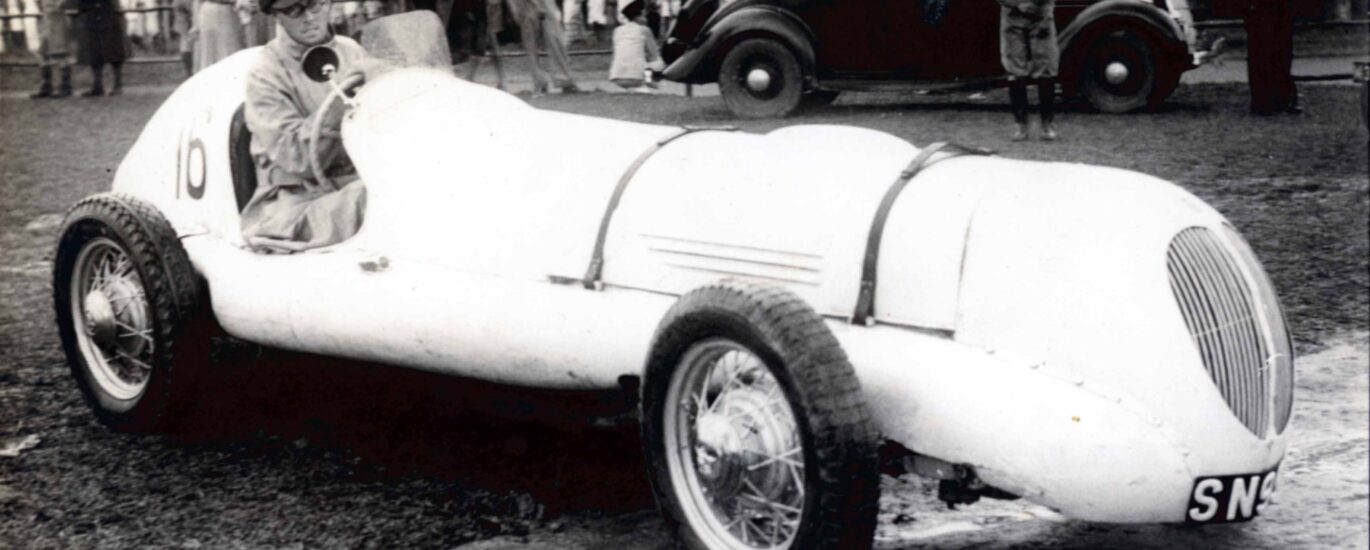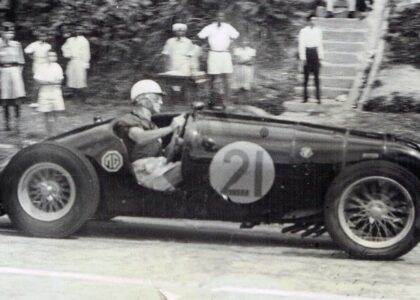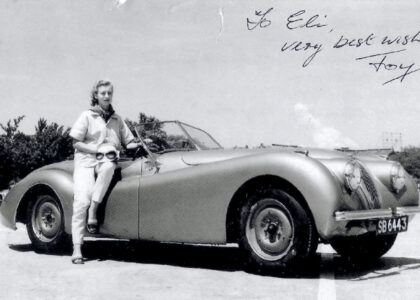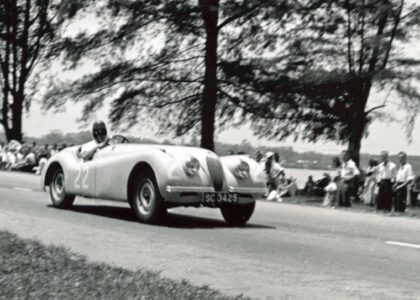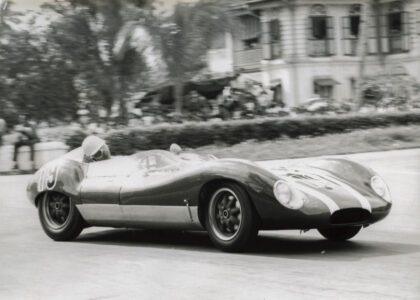By Eli Solomon
Last Updated with additional images on 15 February 2024
John Conrad Henry Oldham[1] (b.1904 – d.1956), better known to the local community as Judge Conrad Oldham, arrived in Singapore on 17 June 1938 to take up a post as magistrate of the Straits Settlements. Later on, he assumed the post of Singapore District Judge in the Singapore Second Police Court. Oldham is credited with several seminal decisions on criminal law in pre-war Singapore but there was much more to the man than just jurisprudence.
Oldham was born in Conway, Caernarvonshire and was educated at Dulwich College. He was called to the Bar (Gray’s Inn) in 1929. His interests were varied – theatre, motor sports and boating mainly. In England, Oldham was chairman of the Poole[2] Speed Trial Committee[3] and drafted the regulations for that competition, which dated from 1936.
When he arrived in Singapore there was a buzz about the place – all the ingredients of theatre, sailing and motor sports were here in “the Gibraltar of the East”, the “impregnable fortress” for Conrad Oldham to savour.
Malayan motor racing was on the ascendency and 34-year-old Oldham was at the right place at the right time. All he needed was the right person to prepare a car for the sprints and hill climbs on the Automobile Association of Malaya’s 1938 calendar which included events such as the Seremban Half-Mile Speed Trial (on 11 September), the Farrer Road Speed Trial in Singapore (on 25 September), and the Mount Pleasure Hill Climb in Penang (on 23 October). Naturally he became a member of the Singapore Branch of the AAM and was soon in the thick of things.
On 19-20 February 1939, the AAM held its biggest event to-date, a two day show that included a motor rally and ended with a Concours d’Elegance at the Sea View Hotel (1906-1964), followed by dinner and dance at the Adelphi Hotel (circa. 1850-June 1973). Sunday saw a gymkhana and treasure hunt. Oldham was one of the Judges of the concours, together with Lady McElwaine[4], a keen motorist herself, and fellow yachtsman, solicitor, and then Chairman of the Singapore Branch of the AAM, Mr G.M. Coltart[5].
SEEK OUT THE WIZARD: When he felt the urge to participate in the speed events, rather than importing a race car or purchase something sporty locally, Oldham tracked down local “Car Doctor” Lim Peng Han. Lim operated Lim Motor Garage on Veerasamy Road, between Serangoon Road and Jalan Besar. Lim’s first workshop was a hive of bustling, noisy, horn-blaring activity. It was one of the very few workshops on the island, and indeed in Malaya, prepared to undertake to build a car from scratch, even if the donor chassis had come from a to-be-scrapped taxi from a breaker’s yard. The young Lim had raced at Brooklands and Donington in the early 1930s, and in 1938, Lim Motor Garage was the go-to place for interesting sports cars and body custom work. Oldham paid a visit to Lim Motor Garage and commissioned a race car.
Work on Oldham’s Special began at a frantic pace. The Judge already had a Ford saloon, a side-valve engine 3622cc V8 which he was prepared to drive up country for speed events. Lim had a similar 3622cc engine in mind for the Judge’s Special. Oldham wanted a unique shape – in the lines of one of the more successful cars from the European racing scene. When it was completed, it was observed that it looked like a Grand Prix ERA, but what Lim had fashioned was closer in shape, and indeed length, to Kaye Don’s 1929 Sunbeam Silver Bullet land speed record car [https://en.wikipedia.org/wiki/SilverBullet_(car)]. Lim’s creation might just as well have had twin straight-8 engines mated back-to-back because the prodigious bonnet length dwarfed even the well-known SS100 Jaguar sports car raced by John Barraclough in Malaya!
NO APPARITION: Altogether, Lim was tasked with completing three cars for an upcoming hill climb – Lieutenant Peter Braid’s 1½-litre single-seater called the L.A. (Lim Automobiles) MG Monoposto, which had previously carried an MG MPJG motor; Lim’s own 3.7-litre V8 L.A. Special; and now, the Judge’s car. Lim walked the walk as well, the Judge was to be part of the crack L.A. Team for the Gap Hill Climb on 11 June 1939. By this time Lim’s Veerasamy Road garage had been relocated to Hamilton Road, a short distance away.
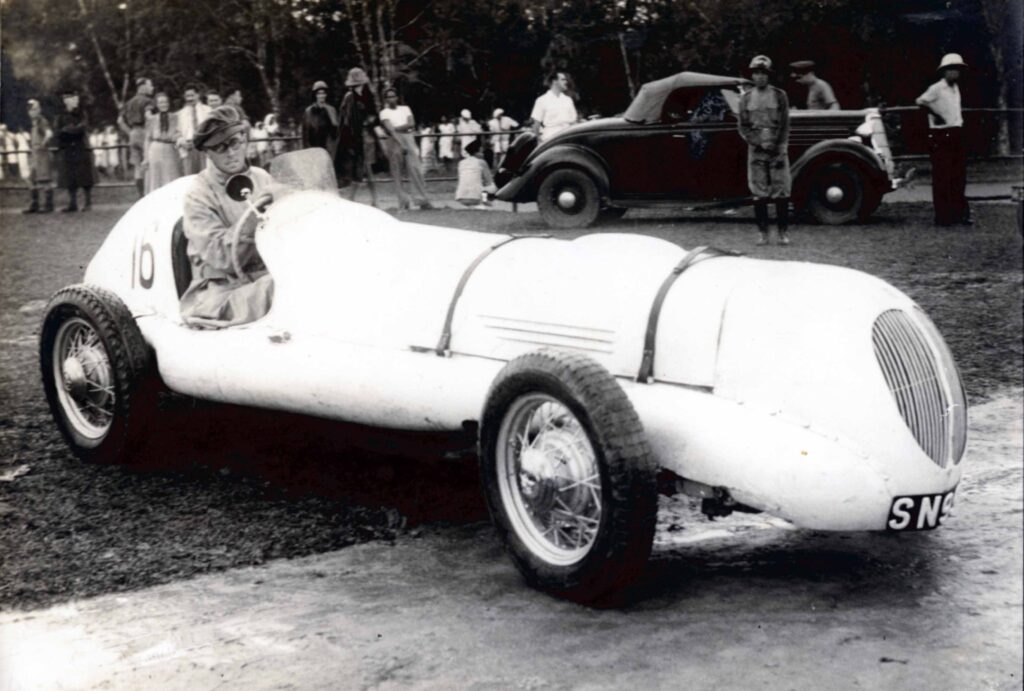
Oldham and his Ghost at the 1940 Johore War Effort Grand Prix.
The Ghost, the name bestowed on the car, sorely needed testing. Nonetheless, it was road-registered – SN999. No, this wasn’t the emergency telephone number of Lim Motor Garage. The number he would have had to phone was 6603.
LENGTHY ISSUES: The No.45 car was simply too long for the Gap. While Lim set FTD and the L.A. Team walked away with the two fastest times, the Judge, chairman of the Singapore Branch of the AAM, wasn’t having it his way. On one of his runs, the car provided some entertainment when it spun, finishing the run in reverse. There was raucous laughter amongst onlookers as Oldham, resplendent in crisp white shirt and tie, sped backwards past the finish line.
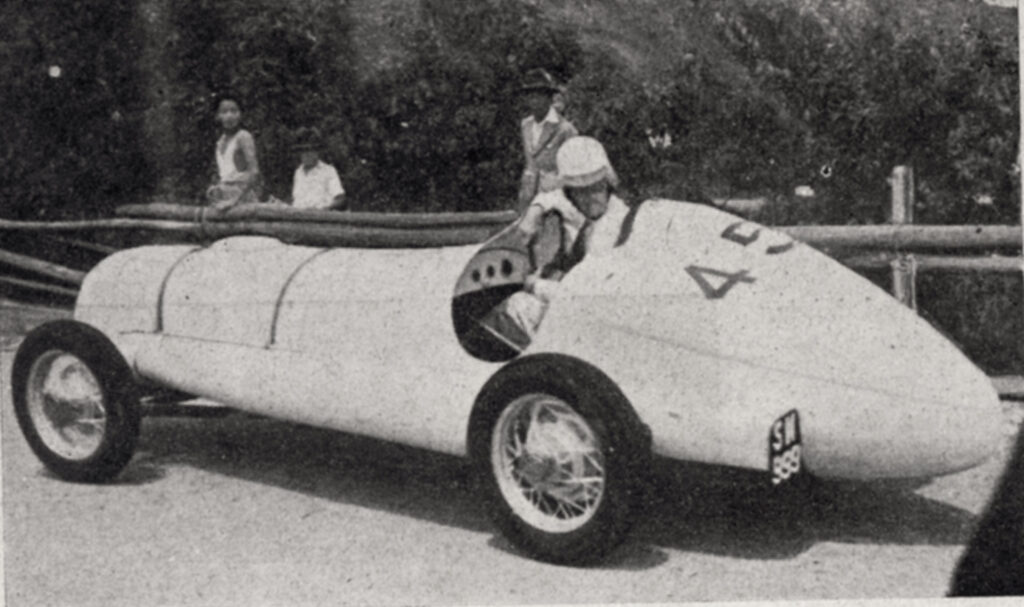
Back to the drawing board for the imposing car and more fettling before the next big event – the Perak Automobile Association of Malaya’s Easter Holiday hill climb, south of Ipoh at Gopeng, on 24 March 1940. This time, Oldham had his own team, partnering Barraclough in his 2½-litre Jaguar SS100 and Jimmy Milne in a Mercury Coupe. In fact, so enthusiastic was the Judge that he entered two teams – the other team consisting his Ford V8 Saloon, Neville George ‘Red’ Reddish in his supercharged Austin Seven Ulster, and Captain R.D. Bell in his Alvis Speed 20. Once more, Lim, now in his new L.A. Special (Number 2), set a new course record of 35.9 seconds. It was a good two seconds faster than the Ghost’s 38-second run, though the Ghost was over a second faster than the SS100. Honour partially restored.
It was a busy period for the Judge. He had recently acquired a six-metre racing yacht, Tarbet, a Bermudian rig sail craft that had been registered in Singapore on 12 May 1932 and was actively raced in inter-port events around the Malacca Straits, Java and Sumatra. If he wasn’t racing his Fiat, Ford sedan or the Ghost, he could be found at the Royal Singapore Yacht Club regattas with Tarbet. A week before the 28 April 1940 Singapore Branch of the AAM’s biggest annual event, a Gymkhana at Keppel Golf Club, Oldham was racing Tarbet at a regatta.
Not two months later, the Judge was up in Malaya again, this time for the Seremban Half-Mile Sprint at the 1st Mile Seremban-Tampin Road on 12 May 1940. There was an exotic gaggle of entries – an ex-Grand Prix Maserati 4CS, a Frazer Nash BMW 328, Lim’s new supercharged L.A. Special, a 2.3-litre Bugatti Type 35, a pair of SS100s, Malaya’s latest import, the ex-Horton/Gardner record-breaking supercharged MG K3 monoposto, not to mention the various other bitzas and MGs. Given a good, long straight, the Ghost could have beaten everyone else. Oldham was third in the Unlimited class, but damage had been done to the Ford V8 engine. With the next Gap Hill Climb in Singapore due in August and the Johore War Effort Grand Prix due in November, some changes had to be made quickly, and so the Chairman of the Singapore Branch of the AAM headed back to the crowded number 7 Hamilton Road garage for some fresh ideas from fellow AAM committee member Lim. There was already a queue outside Lim Motor Garage.
A couple of weeks after the 12 May 1940 Seremban Sprint racing the L.A. Ghost, Oldham was out in the open seas racing Tarbet on 2 June 1940. He made a filing to have the name of this lovely yacht changed to Thelma VI in the middle of July.
The Ghost made it to the War Fund Gap Hill Climb on 4 August 1940. For those in the know, this was really the preliminary before the big War Effort Grand Prix in Johore that coming November. Lim already held the record for cars up the half-mile Gap (44.8 seconds), the most popular, and only local race event. At the Gap that August, the Ghost barely made an impact while Lim lowered his record twice, the final attempt down to 43.6 seconds.
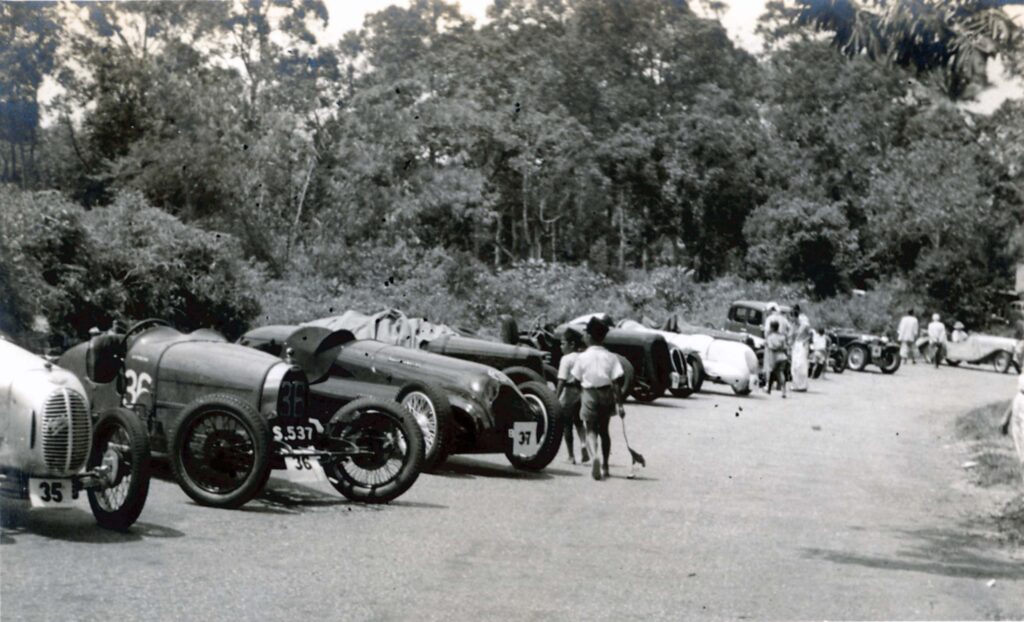
GRAND PRIX GHOST: Come the Johore War Effort Grand Prix, really the last hurrah before life in Malaya was turned upside down, the cream-coloured Ghost was finally ready. “It’s a very tricky course,” the Judge remarked. Two fast practice laps put him in the top three in practice on 11 November, ahead of Captain Peter Braid’s Braid Special and Mick Jennings in the supercharged MG K3. It looked promising but Oldham knew his projectile would have trouble negotiating the hairy hairpin bend at Jalan Ngee Heng. And there were three such hairpin bends over the 1.6-mile road circuit. With practice scheduled on the 11th and racing on the 16th and 17th, lap times were falling rapidly with the magical sub-2 minute lap within reach. Indeed Arthur J. Loughborough’s 1496cc Fiat-Wolseley 1.5-litre hybrid Alpha & Omega Special set a blistering FTD at 1min 46 4/5 sec which only the wizard of Malayan motor racing Lim could only sniff at in his L.A. Special. Oldham’s Ghost was outclassed. Fastest car on the straight and slowest into the corners, when the scratch races for the racing cars were held on Sunday, 17th, the Ghost was well behind the front runners by a fair margin and only the Alvis Speed 20 was slower than the Ghost. With rain scuppering the main races, the closing events were pushed to the following weekend, making the farcical Johore War Effort Grand Prix a three-weekend event.
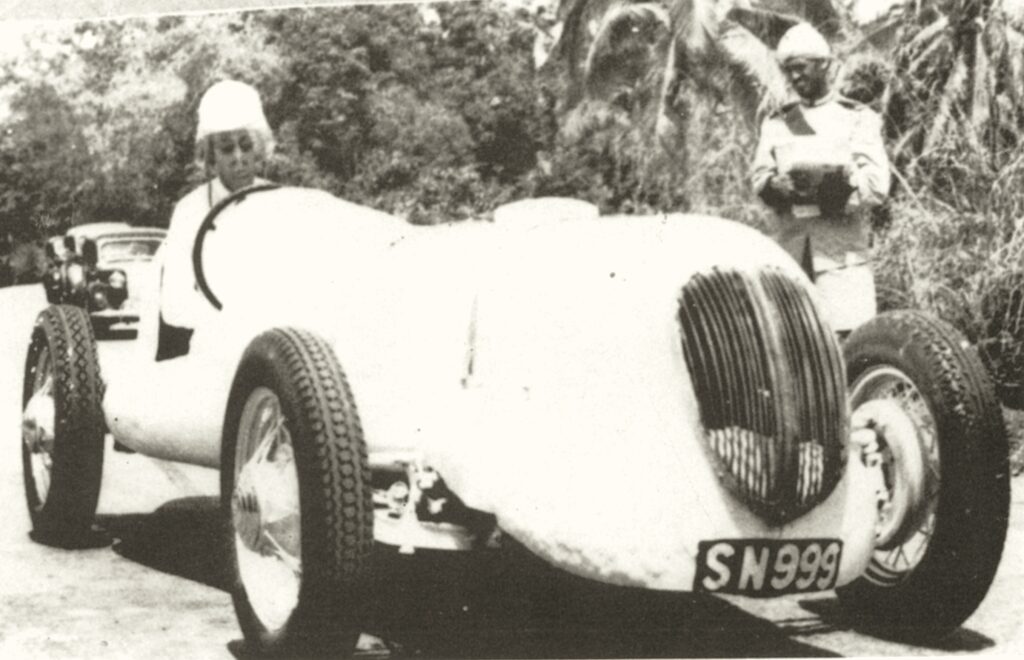
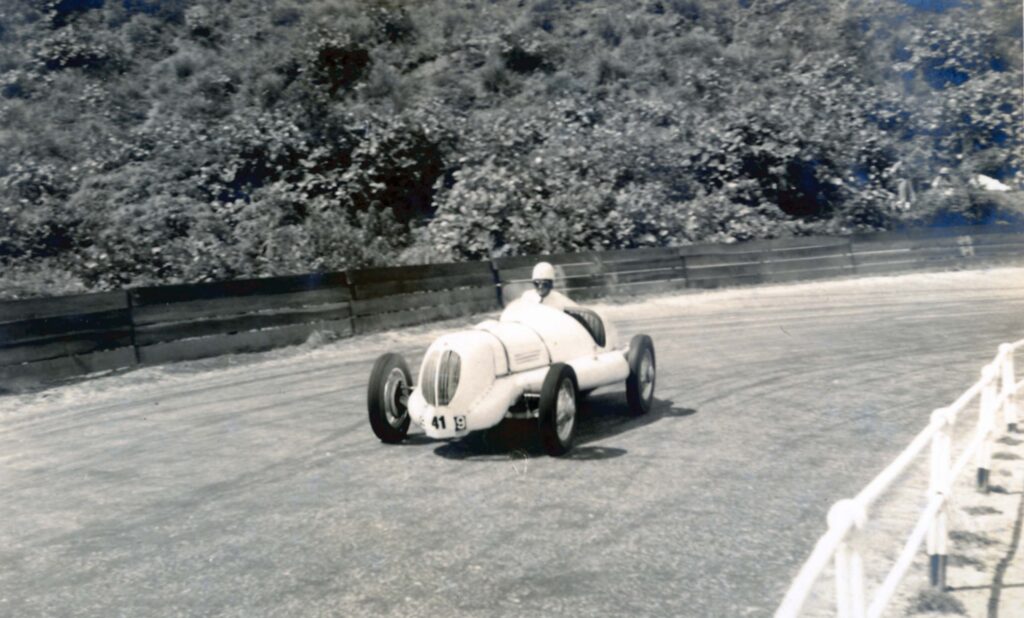
At the First Bend during the 1940 Gap Hill Climb. Oldham’s Ghost was a “monstrosity”, according to some.
What of the Grand Prix race itself? Fl/Lt Anthony Dockray Phillips won ahead of Red Reddish and Jimmy Milne. Lap times were not officially announced and only 5½ laps were completed after two accidents put paid to the race. Oldham, to his credit, was presented a silver cup for his third placing in the Unlimited Class. The racers packed up, a couple of the cars were put on the market for sale, and everyone went home, including the Ghost to its lair at 33 Malcolm Road in Singapore. For Lim, at least six of the 16 entries had passed through his thriving Veerasamy Road and Hamilton Road garages. Lim packed up his Hamilton Road workshop and relocated Lim Motors to numbers 9 & 11 Penhas Road.
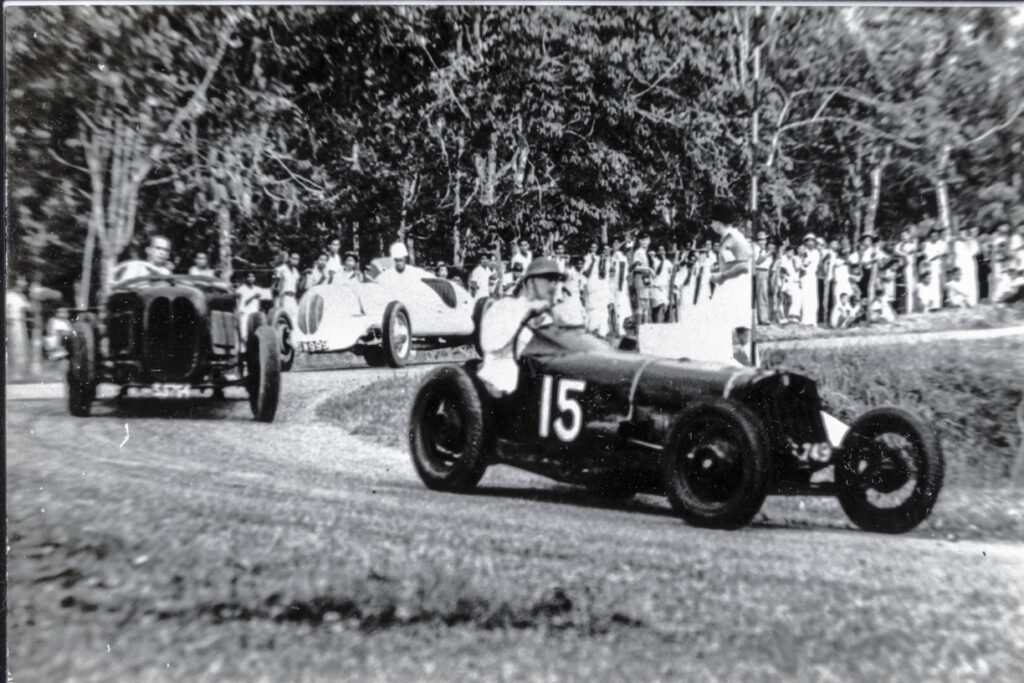
With motor sport now a distant memory, Oldham immersed himself into his court work, evidenced by his lack of involvement in another of his interests, the theatre. He remained interested in motoring matters and was re-elected Chairman of the Singapore Branch of the AAM in April 1941. In September 1941, he presented a trophy at the Aeromodellers’ Annual Competition. At the second annual Aeromodellers meet in Singapore, Oldham presented a trophy to the winner, which incidentally was won by fellow motor racing man, E.H. ‘Ted’ Holloway, for the second straight year.
Oldham was still presiding in court charging people for contravening the lighting regulation during the brownout on 26 December 1941. The Japanese 25th Army had already moved into northern Malaya on 8 December 1941 and soon after began bombing strategic sites in Singapore.
Oldham continued to preside in court in early January 1942. He was already part of the Federation Mine Watching Corps (FMWC) as its second in command. The local scene was dire. Even banks were only operating in the mornings, closing at 12 noon. If Oldham had tried to leave the island via one of the many shipping lines operating, he shouldn’t have found it difficult to get a berth, given his position in the AAM and the judicial service. But he didn’t.
Oldham’s biggest race was just about to begin. He nautical interests[6] saw him take an active, if futile, interest in the FMWC which came under the direction of Rear Admiral, Malaya. 38-year-old Oldham, R.N.V.R., was its 1st Lieutenant. Oldham’s mine watching duties ended when, by end January 1942, most, if not all of the military craft of the flotilla had been sunk by the Japanese. He couldn’t return to England as all departing vessels were now packed with evacuees.
OCEAN RACE: But there was another avenue and like C.O. Jennings that very week, he decided to take his life in his own hands and set sail on his own boat, Savage[7], a 32-ft (9.7m) sloop. “For the next ten days, while Oldham was preparing Savage for the voyage, the lagoon in which she was moors was frequently bombed by Japanese aircraft. Eventually Oldham and his crew set sail, but almost immediately a formation of enemy bombers launched an attack on Chinese junks and naval craft nearby and a cluster of bombs fell just 25 yards from Savage on either side. ‘The yacht was leaping wildly out of the water with the impact,’ Oldham later wrote, but amazingly Savage was relatively unscathed, though the dinghy they were towing sank. As they sailed away in a building, following breeze, ‘enemy planes were plastering Singapore with bombs’. After a four-day voyage – during which they had to negotiate a minefield, cope with ferociously strong tides in narrow unfamiliar rocky channels for which they had no charts, and had a bullet fired through their mainsail by the rear gunner in a Japanese bomber – they arrived in the Indragiri River on the east coast of Sumatra. In the first village they came to, the district officer told them that Singapore had fallen the previous evening.”[8]
The Royal Naval Volunteer Reserve posted a list of names of Temporary Lieutenants (Special Branch) for 1942 and in the list is Conrad Oldham, with a 10 November 1942 date by his name. Where he spent the war is not known but he survived and emerged soon after peacetime sailing his 30-top ocean racer Marigold around the UK.
When the war had ended and the Japanese surrendered in 1945, Oldham’s Ghost, like many of the cars on the Johore Grand Prix grid that eventful November, had simply vanished into thin air, as had his sailboat Thelma VI. Oldham survived the war and returned to Dorset. He became Chairman of the West Hants and Dorset Car Club (1946-1948) while he continued to practice at the bar in the West of England. When the club was officially incorporated in 1951, Oldman was listed as one of the Vice Presidents (address at Exchange Buildings, Bournemouth). He continued to maintain contact with Singapore and was Chairman of the International Committee of the Rotary Club at Bournemouth as well as Chairman of the Union Committee of Singapore based in the UK[9]. The Ghost had long since returned to the ether but Marigold, his 30-ton ocean racer that was purchased in the UK in 1946, continued to carry the Royal Singapore Yacht Club flag[10].
Perhaps, like Lim Peng Han had done, Oldham quickly buried his Ghost in the grounds of his Malcolm Road home when it was clear that Singapore would fall in mid-February 1942. Perhaps he scuttled Thelma VI before fleeing Singapore for good. Perhaps 33 Malcolm Road still harbours Oldham’s Ghost. Time to bring out the metal detectors and go for a good sweep of the grounds?
Sources:
On Oldham as a magistrate: Santa Clara Journal of International Law. Volume 12, Issue 2, Article 3. 5-27-2014
Radics, George Baylon, Ph.D., J.D. Singapore: A ‘Fine’ City: British Colonial Sentencing Policies and its Lasting Effects on the Singaporean Corporal State.
Sharp, Nigel. Troubled Waters: Leisure Boating and the Second World War.
Solomon, Eli. Lost Circuits: Motor Racing Tales From The Far East, Vol.1 (unpublished)
[1] Norman Henry Oldham, Conrad’s father, was born in Sale, Cheshire, England on January 1880 to Joseph Oldham and Mary McGrath. Norman Henry Oldham married Lucy Alice Phillips and had 3 children. He passed away on 30 Mar 1939 in Aysgarth, Cobham, Surrey, England. Conrad’s brothers were Norman De Launay (1907-1973) and Michael Hugh Risden (1929-1997).
[2] The origins of the present Bournemouth & District Car Club stretch back to 1932, when the West Hants and Dorset Car Club was formed in Bournemouth. This Club prospered with a small but enthusiastic membership and in 1936 ran its first speed event, a 680 yard sprint in Poole Park. The event was a success and further events were held in 1937, 1938 and 1939, all events raised money for the then Poole Cornelia Hospital, now of course Poole General Hospital.
[3] Prior to his arrival in Singapore, Oldham served as a private practitioner with local chambers in Bournemouth, Southampton, and London, and it was reported that he appeared in a number of big criminal hearings. In addition to his practice, Oldham also enjoyed auto-racing. He served as chairman of the Poole Speed Trial Committee for three years, often drafting the regulations under which its competitions were held. Source: Singapore: A ‘Fine’ City: British Colonial Criminal Sentencing Policies and its Lasting Effects on the Singaporean Corporal State by George Baylon Radics, Ph.D., J.D. SANTA CLARA JOURNAL OF INTERNATIONAL LAW XXX (2013)
[4] Lady Margaret McElwaine was the second wife of Sir Percy Alexander McElwaine KC (21 September 1884 – 24 October 1969), a lawyer and judge who served, inter alia, as Attorney General of Fiji and Chief Justice of the Straits Settlements up to the surrender of Singapore to the Japanese in February 1942.
[5] Gilbert McCallum ‘Tiger’ Coltart was born in Oswestry, on 14 May 1906. He subsequently worked in the Colonies and was a Solicitor, Partner for Rodyk & Davidson, of 4 Raffles Place, Singapore. Arriving in Singapore in 1929, he was granted a commission in the Singapore Royal Artillery Volunteers, (S.S.V.F.) on 8 May 1929. He was also a keen yachtsman. When the British surrendered Singapore on 15 February 1942, Lieutenant Coltart, like his friend Conrad Oldham, attempted an escape on the 16th February – on his 24-ft racing yacht ‘Mowgli’. It didn’t work out but he did survive the war (d. October 2004). The nicknamed ‘Tiger’ came about not for his fearlessness but for a particular pair of striped swimming trunks that he wore!
[6] Oldham owned Thelma VI, a 5.5 ton yacht from early 1940, having purchased Tarbet from Leslie Robert Blake and renamed her Thelma VI. Tarbet (vessel number 156347) was a Bermudian rid sail boat that was built in Amsterdam in 1926 with a registered tonnage of 6 tons. It was registered in Singapore on 12 May 1932 and was actively raced in inter-port events around the Malacca Straits, Java and Sumatra.
[7] The author is unable to locate a sloop of that name. However, a similarly named vessel, number 173069, was registered in Singapore on 13 November 1941, listed as 10 ton motor boat.
[8] Troubled Waters: Leisure Boating and the Second World War by Nigel Sharp
[9] Oldham returned to England to a 150-room Elizabethan mansion in the heart of the New Forest.
[10] Straits Times 9 December 1946 – photo of Oldham at the helm of Marigold, his 30-ton ocean racer (Royal Singapore Yacht Club) sailing in the English Channel. Mr and Mrs Oldham had returned to England and were living at Victoria Chambers, Bournemouth.

